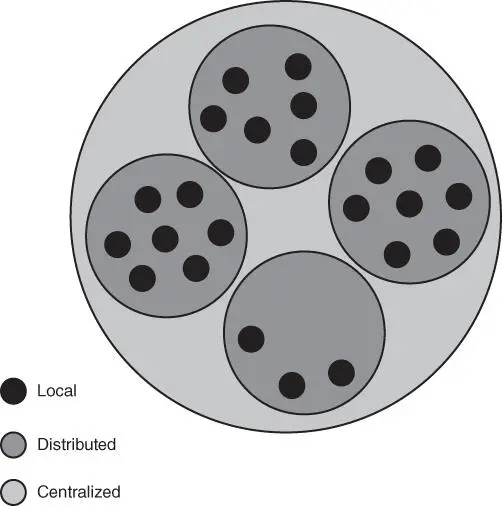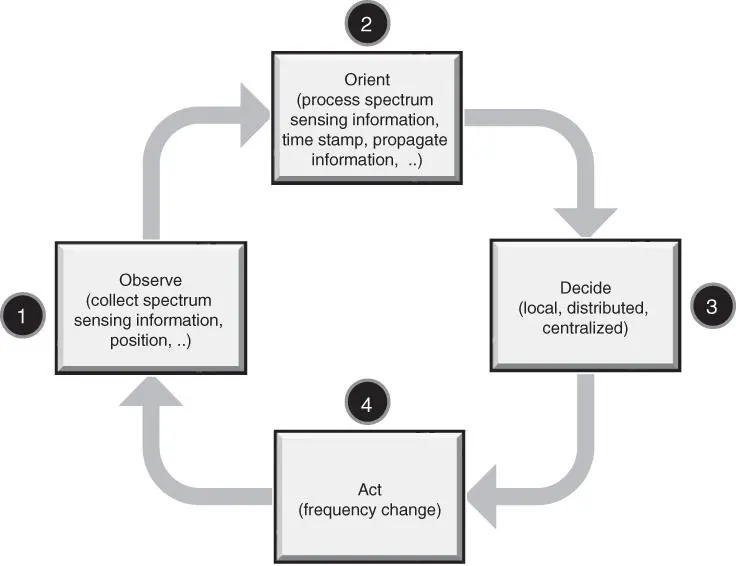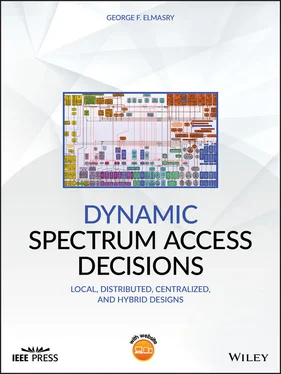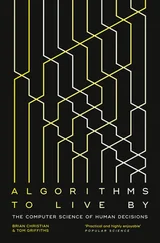Figure 1.1shows a notional view of this decision‐making hierarchy. A distributed DSA decision has to consider that multiple local DSA processes can cooperate to dynamically solve a spectrum access challenge in near real time. Consider the case of a distributed MANET network where the nodes' distributed agents can make local decisions such as listening on a different frequency band while the distributed agents make cooperative decisions regarding DSA aspects such as beam forming, power increase/decrease, and changing the error control coding mode. In addition, multiple networks can have local and distributed decisions but these networks are also part of a centralized decision‐making process that is running on a centralized network manager.

Figure 1.1Hybrid DSA decision making.
As the reader proceeds through this book, the notional view in Figure 1.1will be seen as an oversimplification. It is meant to introduce a concept. The reader will see how in a set of heterogeneous MANETs, network gateways can perform a global cooperative distributed decision‐making protocol that is different from the distributed cooperative decision making within a network (local to a network).
Using machine learning based engines to make these decisions can also be local, distributed, centralized or hybrid implementation. The designer of a DSA system should not limit machine learning approaches to a specific area although the design has to keep in mind that machine learning techniques should be used when they are likely to produce better decisions than stochastic model decisions. The design of a point‐to‐point link operating at a cutoff threshold of a signal‐to‐noise interference ratio (SNIR) relying on a local spectrum sensing to avoid using a jammed frequency may not need a machine learning technique. This is because the cutoff SNIR is based on the physical layer stochastic models and the best machine learning approach will perform as good as a stochastic decision‐making process in this simple case. There is a golden rule regarding the use of machine learning approaches: If a stochastic model gives the same performance as a machine learning technique, why complicate a design? The design should consider the stochastic model. As a rule of thumb, machine learning based techniques perform better as the number of factors contributing to a decision increases and as the uncertainty and change of behavior of the formed network change based on many surrounding factors. In most cases, DSA design should use a cognitive engine approach while relying on stochastic models for processing the raw physical layer metrics.
Sharing information in a distributed or centralized manner combines spectrum sensing information results from a much larger sample of measurements than a local node has. This information sharing can reduce noise uncertainty and overcome other signal distortion challenges. The downside of sharing sensing information is the need to develop mechanisms for information sharing that minimize bandwidth consumption from spectrum sensing information control traffic. The design has to consider a tradeoff between the gain obtained from DSA capabilities and the loss of bandwidth used by the DSA control traffic.
Figure 1.2shows a conceptual view of the DSA key processes regardless of how and where it is implemented. Local, distributed, and centralized aspects of the DSA processes have to follow the theme of observe, orient, decide, and act. The observation process can include obtaining spectrum sensing information coupled with position location information [e.g., global positioning system (GPS) locations]. The orientation process can include processing of local spectrum sensing information and adding time stamps to the spectrum sensing messages distributed to peer agents and to the centralized arbitrator. The orientation process can also include fusing spectrum sensing information received from peer agents to gain a more comprehensive view of the spectrum use status. The decision process can be local distributed or centralized decisions and it can include frequency band change or changing the communications mode of a waveform. 4The action process has to ensure synchronization of frequency change such that all the nodes in the network switch to the new frequency seamlessly and without losing any OTA transmitted frames.

Figure 1.2DSA processes.
It is important to note that spectrum sensing information has to be tied to both time and location. It has to be time stamped before distribution to peer agents or to the central arbitrator. Spectrum sensing information has to have geolocation information of the sensing node. Some rudimentary centralized DSA techniques can use location and time stamp information in the absence of spectrum sensing information to assign nonconflicting bands to a large‐scale set of heterogeneous networks. This approach can be used when dedicated frequencies are assigned to the set of heterogeneous networks and assuming the absence of external users of these frequency bands. Frequency reusability with this case is purely spatial.
Software‐defined radios (SDR) and software‐defined networks (SDN) helped us do away with the old open systems interconnection (OSI) model. The line between the MAC and network layers is now blurred. When we think of machine learning based decision making, we can put it in the context of a MAC layer or a network layer. The 5G standardization uses the context of an open wireless architecture (OWA) where the system designer has the flexibility to add these machine learning techniques to the OWA layer as software modules. Thus, this book will not attempt to label DSA techniques as internet protocol (IP) layer techniques or MAC layer techniques. Rather, the book attempts to guide the reader to consider how to make the best out of the spectrum sensing assets and to decide what decisions can be made locally, what decisions can be made in a distributed manner, and what decisions can be made in a centralized location.
1.2 The Hierarchy of DSA Decision Making
When a dynamic spectrum access decision is made locally, it can be made quickly. If we are considering a point‐to‐point link that has the flexibility to choose between different frequencies and its spectrum sensing has a simple SNIR threshold to compare to when using one frequency, it can simply decide that SNIR on a used frequency is low and switch to a different available frequency. In a distributed MANET, where we have to make cooperative distributed DSA decisions, propagation time of spectrum sensing information, processing time, and the need for making synchronized decisions will produce a relatively slower decision‐making process. In a centralized decision‐making construct, the decision time will even be longer as the spectrum allocation arbitrator has to obtain information from a large‐scale set of heterogeneous networks and make slower, more lasting decisions. Centralized decision making is global, has to coordinate between all networks, has to consider geographical separation between networks, and cannot be performed every short period of time.
Figure 1.3shows a conceptual view of this decision‐making process timing where T 1represents local decision‐making time, T 2represents distributed decision‐making time, and T 3represents centralized decision‐making time. In Figure 1.3, T 1 T 2and T 3are expressive of both the speed of making DSA decisions and the time periods between making DSA decisions. Figure 1.3, by no means uses an accurate time scale but is meant to illustrate that in a hybrid DSA decisions system many local decisions can occur before a distributed cooperative decision can occur, and many distributed cooperative decisions can occur in different networks before a centralized arbitrator decision can occur.
Читать дальше














